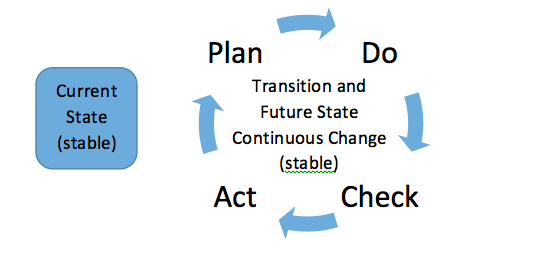How is the transformation to a culture of continuous improvement affected by the underlying thinking in how organizations change?
Organizations have four major components:
- Task(s) of the organization – the work to be done
- Individuals who do the work
- Formal organizational structures – processes, reporting structure, reward systems, etc
- Informal organizational arrangements – how the organizational actually functions
These four components are all interdependent and seek to have equilibrium (Nadler & Tushman 1980). When there is equilibrium between the components the organization is balanced and stable. Because organizations are systems when there is a change in one or more of the components balance is lost resulting in instability. As the system seeks to get back to a stable state organizational change occurs as a transition state between a stable current state and a stable future state (Berkhard & Harris 1977, Nadler 1981).

The uncertainty of the transition state results in three problems that are cited as being inherent in change: resistance to change, management losing control, and political behavior to shape the power dynamics within the organization (Nadler 1981). The instability of the transition state requires a different approach to management. Change management is used to manage this transition to minimize the problems and enable the desired future state to be achieved (Nadler 1981).
What causes the inherent problems of resistance to change, management losing control, and political behavior to shape the power dynamics within the organization? Each of these problems is a response to uncertainty in the organization. Individuals resist change to remove the uncertainty of the unknown future. The formal management system seeks to maintain control to reduce uncertainty. Through the uncertainty people are “playing politics” to best position themselves and their interests in the future state of the organization. All of these responses are assuming that individuals and organizations can only handle uncertainty by seeking to control it through change management – a fixed mindset mentality.
In a lean organization with continuous improvement there is constant change; in other words, the organization is always in transition. The transition is no longer something to manage to minimize problems, but is the new reality of how the organization operates. In order to not have to constantly manage the problems of resistance to change, management losing control, and political behavior to shape power dynamics there needs to be a different approach to managing uncertainty.
An alternative approach to manage uncertainty is through a learning or growth mindset. If instead of needing to control uncertainty we established certainty knowing we can always learn our way forward and overcome any problem. By having a consistent approach to problem solving and change (PDCA) there isn’t a disruption to the equilibrium of the organization when a change is needed to create customer value. The organization can maintain stability and agility.
Yet we still need to address the issue of how to change from an organization that views change as something to be managed to minimize problems to an organization that solves problems by learning using the scientific method. Conveniently, we can use the scientific method to run experiments: I hypothesize that if you approach the change with the behavior you desire, that is exactly what you’ll get.
What behavior does your organization’s change process model?

Nadler, D. A. and M. L. Tushman (1980). “A Model for Diagnosing Organizational Behavior.” Organizational Dynamics, American Management Associations.
Beckhard, R. and Harris, R. (1977) Organizational Transitions. Reading, MA, Addison-Wesley.
Nadler, D. A. (1981). “Managing Organizational Change: An Integrative Perspective.” Journal of Applied Behavioral Science 17: 191-211.




